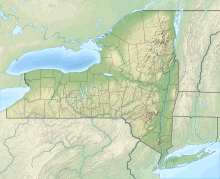
Back Bitva u Benningtonu Czech Slaget ved Bennington Danish Schlacht von Bennington German Batalla de Bennington Spanish Bataille de Bennington French ベニントンの戦い Japanese 베닝턴 전투 Korean Slag bij Bennington Dutch Slaget ved Bennington NB Bitwa pod Bennington Polish
| Battle of Bennington | |||||||
|---|---|---|---|---|---|---|---|
| Part of the American Revolutionary War | |||||||
 A 1780 map depicting troop positions at the start of the battle | |||||||
| |||||||
| Belligerents | |||||||
|
|
Brunswick Brunswick–Lüneburg Iroquois | ||||||
| Commanders and leaders | |||||||
|
|
Friedrich Baum † Heinrich Breymann | ||||||
| Strength | |||||||
|
2,000–2,500 (Stark)[1][2] 350 (Warner)[3] |
800 (Baum)[4] 550–650 (Breymann)[5][6] | ||||||
| Casualties and losses | |||||||
|
30 killed 40 wounded[7] |
207 killed 700 captured[8][9] | ||||||
Location within New York | |||||||
The Battle of Bennington was a battle of the American Revolutionary War, part of the Saratoga campaign, that took place on August 16, 1777, on a farm in Walloomsac, New York, about 10 miles (16 km) from its namesake, Bennington, Vermont. An American force of 2,000 men, primarily New Hampshire and Massachusetts militiamen, led by General John Stark, and reinforced by Vermont militiamen led by Colonel Seth Warner and members of the Green Mountain Boys, decisively defeated a detachment of General John Burgoyne's army led by Lieutenant-Colonel Friedrich Baum, and supported by additional troops under Lieutenant-Colonel Heinrich von Breymann.
Baum's detachment of 700 men consisted of Hessian and British Army troops, Canadian and Loyalist irregulars and a number of Iroquois warriors.[8] He was sent by Burgoyne to raid Bennington in the disputed New Hampshire Grants area for horses, draft animals, provisions, and other supplies. Believing the town to be only lightly defended, Burgoyne and Baum were unaware that Stark and 1,500 American militiamen were stationed there. After a rain-caused standoff, Stark's men enveloped Baum's position, taking many prisoners, and killing Baum. Reinforcements for both sides arrived as Stark and his men were mopping up, and the battle restarted, with Warner and Stark driving away Breymann's reinforcements with heavy casualties.
The battle was a major strategic success for the American cause and is considered one of the turning points of the war; it reduced Burgoyne's army in size by almost 1,000 men, led his Native American allies to largely abandon him, and deprived him of much-needed supplies, such as mounts for his cavalry regiments, draft animals and provisions, all factors that contributed to Burgoyne's eventual defeat at Saratoga. The victory galvanized colonial support for the Patriot cause, and played a key role in bringing France into the war on the American side. The battle's anniversary is celebrated in the state of Vermont as Bennington Battle Day.
- ^ Cite error: The named reference
Nickerson247was invoked but never defined (see the help page). - ^ Morrissey (2000), pp. 25–26 (American forces)
- ^ Cite error: The named reference
Nickerson245was invoked but never defined (see the help page). - ^ Cite error: The named reference
Nickerson249was invoked but never defined (see the help page). - ^ Cite error: The named reference
Pancake136was invoked but never defined (see the help page). - ^ Cite error: The named reference
Morrissey22was invoked but never defined (see the help page). - ^ Crockett (1921), p. 135
- ^ a b The Battle of Bennington: Soldiers & Civilians By Michael P. Gabriel
- ^ Cite error: The named reference
Pancake139was invoked but never defined (see the help page).

